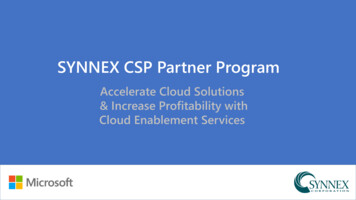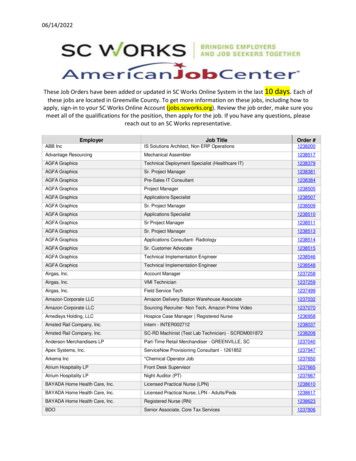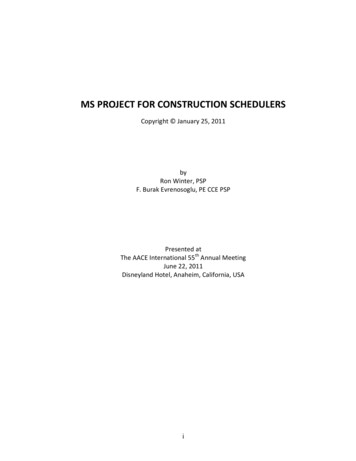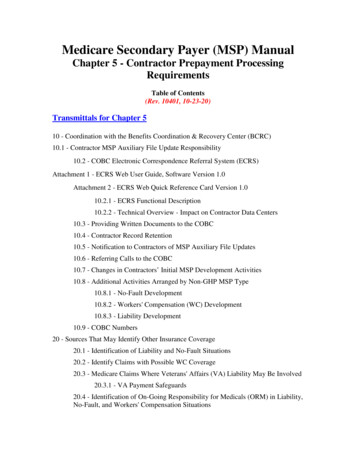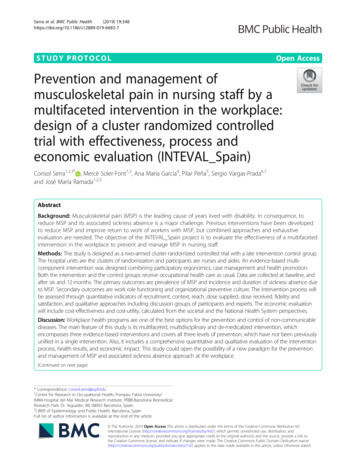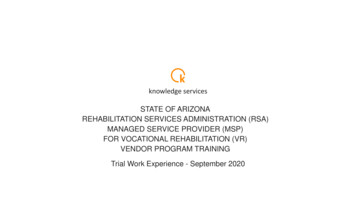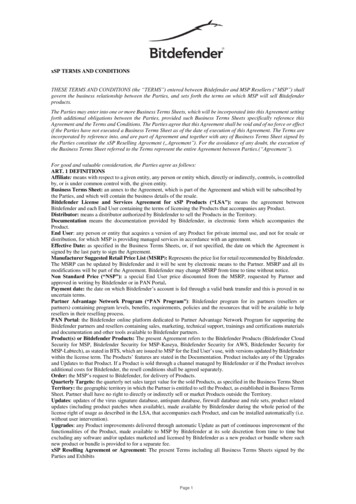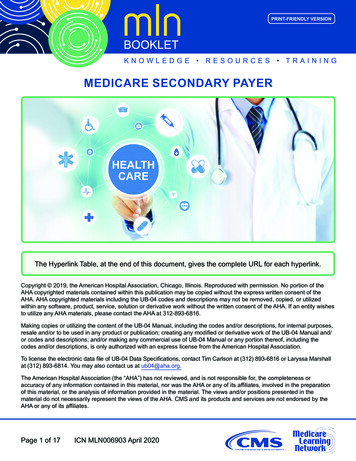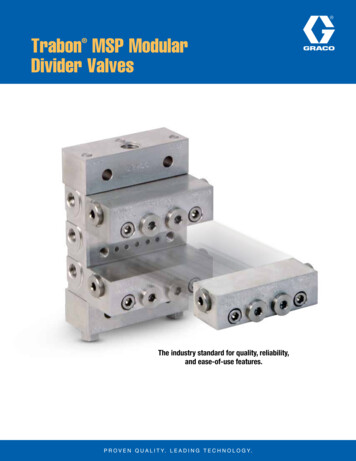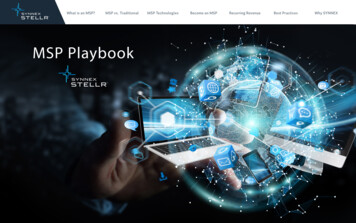
Transcription
What is an MSP?MSP vs. TraditionalMSP PlaybookMSP TechnologiesBecome an MSPRecurring RevenueBest PracticesWhy SYNNEX
What is an MSP?MSP vs. TraditionalMSP TechnologiesBecome an MSPRecurring RevenueBest PracticesWhy SYNNEXWhat is a Managed Service Provider?A managed service provider (MSP) is an IT solutions partner that provides and remotely managestechnological infrastructure for their customers. MSP services may also extend to managingthe end-user systems on a proactive basis (or under a subscription model). In this case,the organization allows the MSP to monitor servers, firewalls, exchange servers, routersand switches, and active directory servers from a centralized console.The modern MSP: Drives a portion of their revenue from recurring services. Over 80% of MSPs incorporate recurring revenue into their business model. Recurring revenue is the portion of a company’srevenue that is expected to continue in the future. 56% of MSPs cater to a specific vertical. The most common verticals are healthcare, finance,legal, non-profit, and manufacturing. 4 4% of MSPs report marketing/sales as their biggest pain point, followed by work life balance. Has a top-of-the-line business continuity and disaster recovery solution as the cornerstoneof their solution set, because for SMBs cybersecurity threats are top of mind. M SPs Business models focus on learning their customers processes, goals, and challenges,while translating that into a solution to simplify their business. Focuses on data. This includes data creation, flow, analysis, and use. The modern MSP willdifferentiate themselves by offering privacy practices.It’s all about increasing the end customer’s productivityContact mspfaeteam@synnex.com to learn more
What is an MSP?MSP vs. TraditionalMSP TechnologiesBecome an MSPRecurring RevenueBest PracticesWhy SYNNEXWhat’s the Difference?Not sure how the managed service provider (MSP) model differs from the traditional model? Here are a few key differences.MSPsTraditionalManagementProactively manages customer’s IT business, reducing downtime and inefficienciesOperates on a break-fix modelAreas of SupportSupports the full businessTypically specializes in one areaRevenueEarns recurring revenue that’s easy to forecast and plan aroundEarns unpredictable income as customers buy what they need in the momentPackagesOffers customizable, affordable packagesProvides a specific serviceSet UpOperates from low to no-touch once they set up a customerConfigures and sets up services and devices after each purchaseProductConfigurationRemotely sets up easy-to-deploy productsConfigures products and service on-sitesHours of SupportProvides 24/7 supportProvides support during normal business hoursAbility to FreeUp EmployeesFrees up customer’s in-house IT employees to focus onmore lucrative/vital activitiesUnable to free up customer’s in-house IT employeeswho are often tied up handling issuesOverheadExpensesBetter manages overhead expenses by having employees work remotelyand proxy into customer’s systemsPerforms on site visits and typically has onsite servers for customersFarms out business to service groups as needed, keeping staff to necessary personnelKeeps employees on staff for two to threeprojects a year while still paying them a salaryStaff NeedsContact mspfaeteam@synnex.com to learn more
What is an MSP?MSP vs. TraditionalMSP TechnologiesBecome an MSPRecurring RevenueHow does the end customer benefit from an MSP model?MSPs constantly managesand monitors their networkSingle point ofcontact for issuesMSPs can remote into theirsystems and fix issues on the spotIf new security threatscome up, easy to implement newfeatures to keep data safeEasy to budget for IT services,especially if they arerecurring revenue customersMSPs offer flexiblebilling models on a monthlyor annual basisContact mspfaeteam@synnex.com to learn moreBest PracticesWhy SYNNEX
What is an MSP?MSP vs. TraditionalMSP TechnologiesBecome an MSPRecurring RevenueBest PracticesWhy SYNNEXWhat Technologies do MSPs Typically Build Around?1Cloud:Cloud services continue to be a top priority for MSPs as more and more businesses orient their technology around it. Cloud technologieshelp businesses streamline their efforts, collaborate effectively, and protect valuable information in an efficient, secure manner. 9 4% of companies are using cloud technologies for their business. The cloud managed services market is expected to reach 82.5 billion by 2025. 65% of SMBs say that cloud and SaaS applications are important technology trends for their business. As more clients shift to cloud-based productivity software,like Office 365 and Google Workspace, there is a major opportunity for SaaS backup to protect those services. Cloud and SaaS protection are one of MSP’s fastestgrowing offerings.Contact mspfaeteam@synnex.com to learn more
What is an MSP?MSP vs. TraditionalMSP TechnologiesBecome an MSPRecurring RevenueBest PracticesWhat Technologies do MSPs Typically Build Around?2Security:In a world where malware, ransomware, and malvertising are an everyday concern, it’s best to leave no stone unturned. Because these attackshappen daily, the best way to ensure your customers stay protected is to provide them with the best cloud technologies in the market.These technologies are producing more sensitive data than ever to help businesses keep their information secure and their security solutionsahead of the malware curve. These impending threats make security a top priority for MSPs. 8 2% of MSPs consider anti-virus the most critical security solution for SMBs, followed by advanced firewall and remotemonitoring and management. On average, there is a hacker attack every 39 seconds. 6 0% of small businesses go out of business after each breach. 44% of businesses estimate they could lose 10,000 or more during just one hour of downtime. One in 323 emails sent to small businesses are malicious. 9 5% of cybersecurity breaches can be tracked back to human error.There is ahacker attackContact mspfaeteam@synnex.com to learn more39everysecondsWhy SYNNEX
What is an MSP?MSP vs. TraditionalMSP TechnologiesBecome an MSPRecurring RevenueWhat Technologies do MSPs Typically Build Around?3Networking:Selling networking on a subscription basis is a relatively new concept. The growth of networking as a service is attributed to the rapid usageof cloud technology as more and more customers move their workloads to the cloud. By 2025, network vendor subscription revenue will be at least 30% of total revenue and could be as high as 50%. Offering networking as a service can allow end customersto have more flexibility and performance gains in theirnetwork infrastructure. The monthly fee coversthe cost of the products, installation, and wirelessnetwork design.– Customers get a lifetime warranty on products andcan upgrade whenever necessary. Plus, customerscan avoid investing capital upfront on hardware. W iFi-based products allow businesses to gathervaluable information and data about their customers.Bundling these types of features with WiFi giveMSPs an opportunity to pitch networking as arevenue driver instead of an operating expense.Contact mspfaeteam@synnex.com to learn moreBest PracticesWhy SYNNEX
What is an MSP?MSP vs. TraditionalMSP TechnologiesBecome an MSPRecurring RevenueBest PracticesWhat Technologies do MSPs Typically Build Around?4Services:Offering services is one of the most popular trends on the market. Services for helpdesks, network operation centers, securityoperation centers, and mobile device management can help your customers elevate their business experience while giving you moreopportunities to grow. Services can be outsourced to save you money and provide more opportunities for growth. SYNNEX has a specificdivision dedicated to the service offerings listed below. Contact your MSP solution specialist for more information. Helpdesk: The top functions that MSPs look for in a helpdesk are ticket logging solutions, question and answer solutions, and an easyway to track customer satisfaction. A helpdesk solution is instrumental in ensuring your MSP practice stays organized and running smoothly.In fact, 87% of MSPs report help desk services as their biggest offering. N OC (Network operations center): Responsible for monitoring andmaintaining the overall network infrastructure. The primary function is toensure uninterrupted network service. S OC (Security operations center) : Centralized function withinan organization employing people, processes, and technology tocontinuously monitor and improve an organization’s securityposture while preventing,detecting, analyzing, and respondingto cybersecurity incidents. M DM (Mobile device management) : The process of monitoring,managing, and securing mobile devices such as laptops,smartphones, and tablets that enterprises use to accessbusiness-critical data.Contact mspfaeteam@synnex.com to learn moreWhy SYNNEX
What is an MSP?MSP vs. TraditionalMSP TechnologiesBecome an MSPRecurring RevenueBest PracticesWhy SYNNEXHow to Become an MSPBecoming a successful managed service provider (MSP) isn’t justoffering your customers managed services. Anyone can do that.Follow these four steps to succeed as an agementDevelop MSP offerings – Define which specifictechnical services you’ll offer and how you’ll bundlethem together. Although you may be able to perform arange of technical services, it’s important to determinewhich ones will bring you the most business at themost profitable rates. In order to narrow down yourofferings consider these questions:SystemSecurityManagedBackup W hich technical areas do you know best?ManagedServices Which types of services are easiest to trainyour current employees and find new ones for? Will offering some services require you to makeinvestments in specialized hardware or softwaretools that you don’t already own? What types of businesses thrive in your area? To standout from the competition, industry-leading MSPs selectmarkets for specialization.Contact mspfaeteam@synnex.com to learn ement
What is an MSP?2MSP vs. TraditionalMSP TechnologiesBecome an MSPRecurring RevenueDecide on business management solutions – You will need tools to power and automate your business.Why SYNNEXTwo tools that a majority of MSPs utilize today are:Remote Monitoring and Management (RMM)These tools help automate essential tasks on the client side, while also allowing you to fixmany of your clients’ issues without spending time on-site. SYNNEX offers thesetools and can assist in making suggestions.Professional Services Automation (PSA)These tools allow you to improve your business productivity through better client handling,fewer errors, and automated billing and reports. Typically, good PSA tools are integratedwith some sort of ticketing system, another crucial tool. SYNNEX’ marketplace integrateswith both ConnectWise and Autotask, two very well-known PSA tools in the market.Contact mspfaeteam@synnex.com to learn moreBest Practices
What is an MSP?3MSP vs. TraditionalMSP TechnologiesBecome an MSPRecurring RevenueBest PracticesWhy SYNNEXDetermine price – Managed service providers (MSPs) can follow several different pricing models and strategies. Here are some of the more popular and useful models.All You Can EatA lot of MSPs have moved away from a break- fix model and have embraced “All You Can Eat,” a flat monthly-fee based model that covers all remote and on-site support.The simplicity of this model is attractive to customers looking to avoid complex pricing structures. It also helps those who want to understand what they’re getting fortheir money. You can set “All You Can Eat” pricing as follows:Per DeviceA flat monthly fee per supported device. This model is beneficial to both you and the customer as it reflects theamount of work performed over time. Some MSPs charge one rate for endpoints and another rate for servers.Per UserA flat monthly fee per user. This pricing would include servicing both endpoints and servers since individual usersoften access both.To determine which pricing model to use, consider the type of company you are working with.For tech-focused companies, both models are viable options. Per-device and per-user pricing often result in similar revenue. However, for companies in other industries(like manufacturing), it often makes sense to charge for all services on a per-device basis. Some employees at those companies may not use a computer for daily tasks, so ifyou charge per user, you’ll end up with less revenue.This is based on your cost of service, your desired profit margins, and your current market influences. One popular pricing strategy for MSPs is to bundle solutions andservices into tiers.Contact mspfaeteam@synnex.com to learn more
What is an MSP?MSP vs. TraditionalMSP TechnologiesBecome an MSPRecurring RevenueBest PracticesWhy SYNNEXSelling as a Managed Service Provider- All Together Best PracticesBilling: Have a cost model that supports business model. Build recurring revenue. Require pre-paid billing A ccount for the service aspect.– This is the most profitable area; you are selling services not products. B reak “IT terms” down simply.– Your customers will most likely not understand technical jargon,explain products and services. P rice offerings fairly– Make sure that your cost helps you deliver the quality of service youwant to give.Contact mspfaeteam@synnex.com to learn more O ffer pricing based on customer’s needs. There is no obligation to offereveryone the same price.– As your customer’s headcount grows so should your fee. G ive yourself a cushion by shooting for higher margins(Aim for 60-70% margin).– Customers are looking for someone they trust. Not a race to the bottom. H ave a minimum fee.– If you price too low, you cannot deliver your services properly. O ffer pricing for total solution instead of a la carte pricing . C hange pricing as needed.
What is an MSP?4MSP vs. TraditionalMSP TechnologiesBecome an MSPRecurring RevenueBest PracticesFind your first customers – There are several ways to find MSP customers. Here are a few ideas. R eferrals are your friend! 68% of SMB end customers report that referrals have the greatest impact when it comes to choosing an IT provider. Promote your business on the Internet or through social media. R eorient your prospective customers. Partner with the best in the game.– Stellr Community– DemandSolv– Capture the Cloud– SYNNEX Go– Mobility Program Find your niche vertical and stick to it. B uild a business network byjoining the local Chamberof Commerce, networking groups,and volunteer organizations.Contact mspfaeteam@synnex.com to learn moreWhy SYNNEX
What is an MSP?MSP vs. TraditionalMSP TechnologiesBecome an MSPRecurring RevenueBest PracticesWhy SYNNEXRecurring Revenue for MSPsIncentivizing Sales Teams for Recurring RevenueRecurring revenue is the portion of a company’s revenue that continues on a regular basis, typically monthly. Unlike one-off sales, recurring revenue is predictable and steady. Recurring revenue models are especially popular in subscription-based “as-a-service” models, like Software-as-a-Service (SaaS) and Device-as-a-Service (DaaS).As a managed service provider, you may charge a monthly fee when fully managing a customer’s IT environment. You may alsoprovide these customers with access to productivity suites, like Office 365 or Google Workspace, for which you also charge amonthly fee. Both are examples of recurring revenue from subscription-based products and services. Office 365- monthly fee charged for the use of business productivity suites Azure- monthly fee charged for cloud computing Flat rate IT fee- one monthly fee to charge customers when fully managing their IT environment(Network monitoring, providing business productivity suites, break-fix, SOC, helpdesk, etc)Recurring revenue models are especially popular in subscription-based “as-a-service” models, like Software asa Service (SaaS) and Device as a Service (DaaS).For example, as a Managed Service Provider, you may charge a monthly fee to customers when fully managing their ITenvironment. You may also provide these customers with access to productivity suites like Office 365 or Google Workspace,for which you also charge a monthly fee. Both are examples of recurring revenue from subscription-based products and services.The subscription economy allows companies to offer more comprehensive customer solution, rather than a “one and done”, drive-by sales pitch. As you could imagine,this also changes the way sales representatives sell solutions has changed, calling for a new incentive model that ensures the entire value of the customer relationship is trackedand measured.Contact mspfaeteam@synnex.com to learn more
What is an MSP?MSP vs. TraditionalMSP TechnologiesBecome an MSPRecurring RevenueBest PracticesWhy SYNNEXThe subscription economy allows companies to offer more comprehensive customer solutions, rather than a “one and done” drive-by sales pitch. Not surprisingly, this also changesthe way sales representatives sell solutions, calling for a new incentive model. Here are the answers to a few frequently asked questions.Q:How do you compensate the sales reps who sell these contracts? And what about the rest of the team tasked with fulfilling and supportingcontracts over the life of the customer relationship? It’s not like selling a physical product or even a perpetual software license where you cansimply pay the sales rep a commission on the price paid.A:With contracts based on a subscription model, revenue is often received and recognized over time, so most of the value of the contract will come.What used to be a one-million-dollar license sale now might be a one-year contract with annual recurring revenue of 200,000. So, do youcommission the sales rep on the 200,000 you get the first year? Or the total contract value of one million dollars?Q:A:Q:A:What’s the best way to incentivize your sales team?First, there is no one-size-fits-all solution. The way you incentivize your sales reps (or channel partners or system integrators) will need to fityour company’s unique sales coverage, channel, and engagement models. Also, your incentive plan will shape behavior–for good or bad–so it’simportant to give careful thought to what behavior you want to elicit from everyone who encounters the customer.What are the most common sales rep incentive plans for a subscription model?Pay early and pay often. Though it is tempting to pay sales teams on cash collected over the period of the customer relationship, this type of paymentcycle can discourage sales teams from closing new deals. With a constant annuity stream coming in over time, sales representatives won’t need to relyas heavily on commission from adding new clients.Track the contract length. A one-year deal is great, but a three-year deal is even better. This is where measuring the total contract value comes intoplay. Develop a model where the value of the deal is understood at signing, and pay your sales team based on that number. However, you should makesure you have an element of breakage in your incentive plan, so you don’t reward reps for closing business deals that never go live.Separate your hunters from your farmers. Once the deal is active, you want your “hunter” reps to go out, bring in new business, and close new deals.Your “farmer” reps can then take over to manage customer relationships. “Farmers” will be measured on growth, renewal, and churn rates.Split up selling opportunities. Depending on your business model, you should split selling opportunities between hunters and farmers. Hunter reps maycome back in to push new opportunities, or farmers may handle it as they may have a more personal relationship with the customer. Identifying theseresponsibilities early on and forming clear rules of engagement for your teams will help you avoid conflict.Contact mspfaeteam@synnex.com to learn more
What is an MSP?MSP vs. TraditionalMSP TechnologiesBecome an MSPRecurring RevenueBest PracticesWhy SYNNEX5 Tips for Top Performing MSPs1Focus on Relationships- 68% of MSPs report increased renewal rates attributed to strong client relationships. B e actively involved S chedule meetings to go over satisfaction rates and emerging needs Consider adding services and products as their needs evolve2Deliver as promised- 45% of MSPs report an increase in renewal rates as a result of delivering on promised service-level agreements (SLAs). Clients want to know they can depend on you to deliver as they expect.3Provide Managed Service- 32% of MSPs report renewal rate growth driven by client adoption of managed services .4Always be Improving- 32% of MSPs report improving service desk processes, efficiency, and automation led to increased year-over-year renewal rates.29 % of MSPs report imporving service tech performance closed more renewals. S cour your operations for opportunities to deliver better service.5Add New Service Options- When your customers express that they need a certain service from you, work or making those needs part of your core offerings. 20% of MSPs report meeting client demand for cloud services driving renewal rates. 16% of MSPs report demand for project-based and professional services work driving renewal rates. 15% of MSPs report diversification of product offerings driving renewal rate.Contact mspfaeteam@synnex.com to learn more
What is an MSP?MSP vs. TraditionalMSP TechnologiesBecome an MSPRecurring RevenueBest PracticesWhy SYNNEXExpand Your Offerings with SYNNEX StellrExpand your offerings with SYNNEX, as the first in the channel to form a team dedicated to the growth and development of managed service providers (MSPs),better enabling our partners to expand their offerings and better serve customers.Why SYNNEX Stellr?15 dedicated fieldand inside sales repsBusiness-led workshopsand 1:1 strategy sessionsKey vendors alignedto MSP offeringsCross sell/upsellkey MSP technologiessReady to get started? We’re to help!Contact the SYNNEX Stellr MSP team at MSPFAETeam@synnex.com.Contact mspfaeteam@synnex.com to learn moreField services available to augmentcurrent partner capabilitiesOpportunity toearn recurring revenueAutomate and scale transactionswith the Stellr MarketplaceView Stellr Line Card
A managed service provider (MSP) is an IT solutions partner that provides and remotely manages . 82 % of MSPs consider anti-virus the most critical security solution for SMBs, followed by advanced firewall and remote . (MSPs) can follow several different pricing models and strategies. Here are some of the more popular and useful models.

